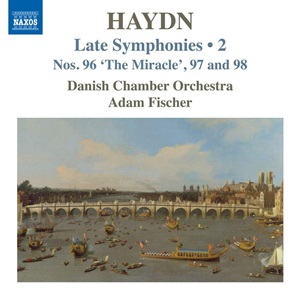
Franz Joseph Haydn (1732-1809)
Late Symphonies, Volume 2
Symphony No 96 ‘The Miracle’ (1791)
Symphony No 97 (1792)
Symphony No 98 (1792)
Danish Chamber Orchestra/Ádám Fischer
rec. 2022, Concert Hall, Royal Danish Academy of Music, Copenhagen, Denmark
Naxos 8.574517 [69]
Having already given a favourable response to the first volume in this series of Haydn’s late symphonies, I refer you to that review for more information regarding Fischer’s approach to this music. Much of what I see about his treatment of the first three London symphonies must surely and equally apply to these three, completing the batch of six Haydn wrote during his first trip to London, where he was given “rock-star” treatment.
He had a very competent orchestra in the band of forty musicians violinist-impresario Johann Peter Salomon had put together and could thus risk writing challenging music. Whether it and its performance here are each of the calibre to convince you of conductor Ádám Fischer’s contention that the only reason why Haydn’s popularity has lagged behind that of Mozart and Beethoven is because of “how it is played today”, I leave to you to decide for yourself, but I repeat the assertion in my first review that the music “receives the best possible advocacy here”. I will, however, confess that I find much of it to fall into the “cheerfully pleasant” – and often very inventive – category, but moments of the kind of profundity encountered in the symphonies of the other two aforementioned geniuses are far fewer.
Lovely woodwind playing instantly characterises the Allegro section following the typical slow introduction of ‘The Miracle’ – so called because when the audience pressed forward to catch a glimpse of Haydn on his appearance they thus all narrowly escaped being hit by a falling chandelier – and the prominent (hard-sticked?) timpani will greatly please those of my acquaintance for whom modern percussion is always too diffident – and the fleetness and neatness of the scurrying string passages are a delight. The Menuetto is typical of the bluff heartiness I associate with Haydn’s more generalised style; the finale is likewise lively and delicate but stiffened and underscored by more timpani thwacks – music which ideally suits the specific sound-world Fischer and his Danish orchestra wish to create.
I find No 97 to be superior to its predecessor, despite its not having acquired a sobriquet (but then, that of No 96 wasn’t actually derived from any feature of the music itself). The slow opening carries faint echoes of the start of The Creation, then the energy invested in the ensuing vivace section, which then surprising mutates into a waltz, makes for a highly entertaining movement and every transition of mood is deftly accomplished here. The Adagio takes us back into “generally charming” mode and relies on a series of variations, again adroitly negotiated by an orchestra always light on its feet – and the piano sul ponticello passage is very nimbly executed. The Menuetto is fairly conventional but the finale springs some surprises and showcases the orchestra’s flexibility at high speed.
No 98 engages in greater emotional complexity and the orchestra “bigs up” its sound to accommodate the music’s larger scale, with the timpanist working overtime. The first few notes of the Adagio cantabile surprise the listener by apparently launching into “God Save the King” but the development is again considerably more complex and more demanding on both the orchestra and the listener. The Menuetto, too, is more substantial in range and scale and I like the way the orchestra broadens and coarsens its sound for the alternately more martial and rustic passages in comparison with the filigree interludes in the preceding symphonies. The Presto finale is another opportunity, however, for them to revert to displaying their skill, versatility and homogeneity.
Those who have acquired the first volume will want this, too.
Ralph Moore
Help us financially by purchasing from





















